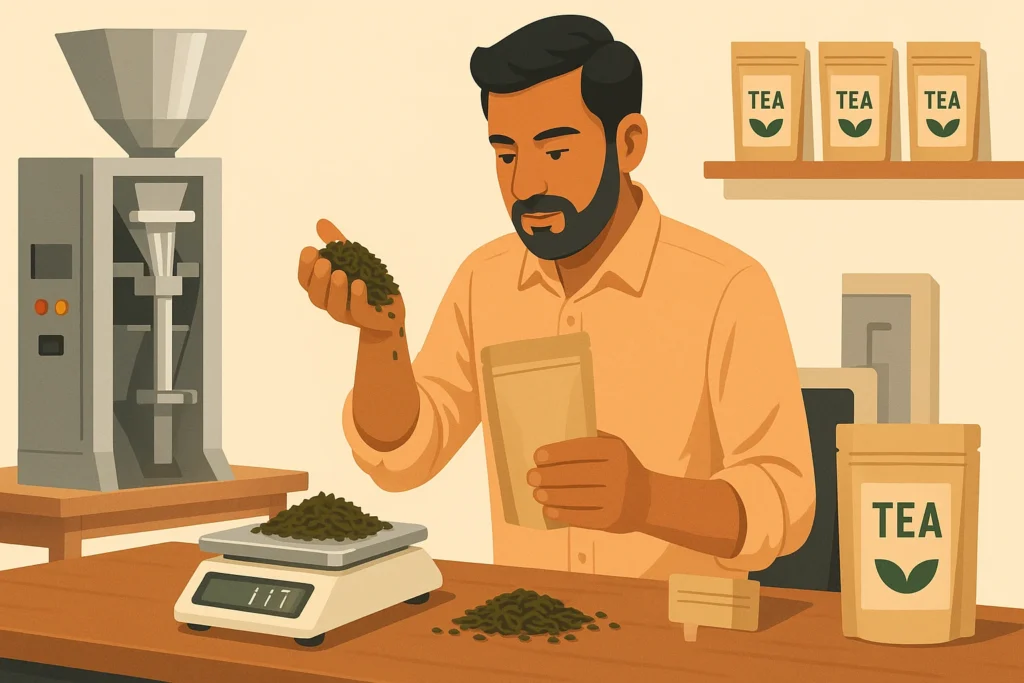The Indian tea industry is legendary — but today, the real action isn’t just in the tea gardens. It’s in tea packaging, branding, and hygienic retail packs that consumers now demand.
With the rise of D2C brands, herbal blends, and premium Assam tea, tea packaging has quietly become one of India’s most promising small-business opportunities.
But like every business, it comes with its own challenges, investments, and lessons — many of which I learned the hard way.
This is my real journey, written to help you understand the opportunities and risks in tea packaging, along with machinery requirements, pouch sizes, sourcing tips, and practical advice no one tells you.
you may also like to read: Tea Business in India: From Assam to the World – My Journey and Opportunities for New Entrepreneurs
Tea Packaging: Where the Opportunity Really Is
Indian tea is booming again — not just as a beverage, but as a lifestyle product.
Key Opportunities in Tea Packaging
✔ Massive Consumer Demand
India is the world’s second-largest tea producer and consumer, and the shift from loose tea to branded retail packs is bigger than ever.
✔ Shift Towards Hygienic, Branded Packs
Consumers no longer trust loose tea sold in shops. High-quality tea packaging pouches now drive brand value and hygiene.
✔ Scope for Niche Brands
- Detox green tea
- Ayurvedic blends
- Masala/Flavored teas
- Premium Assam CTC
- Darjeeling niche brands
You can carve your own space using smart branding and tea packaging.
✔ E-commerce & D2C Growth
Selling through Amazon, Flipkart, Jiomart, ONDC, or your own website gives small brands national reach.
You may also like to read: Why Money Alone Can’t Buy Startup Success: A Real Tea Packaging Story from Assam
My Personal Experience: What I Wish I Knew more Before Entering Tea Packaging
Understand Tea quality ,Types & Grades First
India produces everything from Assam, Darjeeling, Nilgiri, Orthodox, Green, White to flavored teas.
Grades matter even more:
- BOP
- BOPSM
- Fannings
- Dust
- FOP
- Golden Tips
In my early days, I didn’t understand how grades affect taste, strength, price, and consistency.
This delayed my brand development.
I soon learned an important truth:
👉 Tea quality changes with season — especially in Assam. Consistency requires advance sourcing.
🔗 Secure a Reliable Tea Source
You don’t need your own tea garden —
but you MUST have a reliable supplier.
I built relationships with:
- Auction agents
- Local tea gardens
- CTC factories
- Brokers
This helped me achieve:
- Consistent taste
- Predictable pricing
- Regular supply
- Brand stability
Without trust in your supplier, tea packaging is impossible to scale.
Tea Packaging Machinery and Investment
Starting a tea packaging unit requires some machinery depending on your scale.
Key Machinery Used in Tea Packaging
- Automatic pouch packing machine
- Semi-automatic filler machine
- Band sealer / hand sealer
- Tea bag making machine (if planning dip tea bags)
- Batch coding machine
- Weighing scale
Approx investment varies from ₹1.5 lakh to ₹12 lakh depending on automation.
Common Tea Packaging Pouch Sizes
These are the standard pack sizes used across India:
- 50 g
- 100 g
- 250 g
- 500 g
- 1 kg
Custom pouches require investment in:
- Printing
- Design
- Lamination
- MOQ (minimum order quantity)
But strong packaging = strong brand.
⚠ Risks & Challenges in the Tea Packaging Industry
Let’s talk about the part nobody highlights.
Major Risks in Tea Packaging
❌ High Initial Investment
Machinery + pouch printing + raw material = a big upfront cost.
❌ Big Players Dominate the Market
Brands like Tata Tea, Red Label, Wagh Bakri invest crores in advertising.
Competing with them requires smart positioning.
❌ Profit Comes Only With Scale
Tea margins are thin.
Your profits grow only when your sales grow.
❌ Tea Quality Changes Every Season
Especially true for Assam tea.
You must buy and stock large quantities to maintain taste consistency.
❌ Strong Branding & Marketing Required
Without digital marketing, packaging design, offline distributors, and sometimes influencers — quality alone won’t sell.
Final Thoughts (From My Own Entrepreneur Journey)
Starting a tea packaging business can be profitable, but only if you:
- Understand tea basics
- Build supplier relationships
- Invest in the right machinery
- Create strong packaging
- Aim for volume
- Prepare for competition
- Focus on brand building
Tea packaging is not just about filling pouches —
it’s about creating a tea brand people trust.
Summary Tips
- Learn tea quality ,grades etc before investing
- Choose reliable tea suppliers
- Start with semi-automatic machines
- Invest in smart, modern packaging
- Focus on consistency more than variety
- Scale slowly and strategically
FAQ: Tea Packaging Business in India
1. Is tea packaging profitable in India?
Yes, but profits increase only with volume. Small batches have thin margins.
2. How much investment is needed for tea packaging?
A small unit can start from ₹1.5–3 lakh. Fully automatic setups cost ₹5–12 lakh.
3. What tea varieties are best for packaging?
Assam CTC, Darjeeling leaf tea, green tea, masala tea, and herbal blends sell well.
4. Which pouch sizes work best?
50g, 100g, 250g, 500g, and 1kg are the most common.
5. Can I sell tea online in India?
Yes. You can sell through Amazon, Flipkart, Meesho, ONDC, and your own website.
⭐ About the Author
Tabrez is a first-generation entrepreneur and founder of BusinessZindagi.com. With hands-on experience in tea packaging, e-commerce, and MSME operations, he shares practical, real-world lessons for small business owners. His writing blends personal experience with actionable insights to help Indian entrepreneurs grow with confidence.
Authentic Sources & References (Short & Clickable)
- Tea Board of India
👉 https://teaboard.gov.in - Tea Auction Prices (Jorhat & Siliguri)
👉 https://teaauction.gov.in - FSSAI Packaging & Labelling Regulations
👉 https://fssai.gov.in - Indian Tea Export Data
👉 https://commerce.gov.in - Startup India: Food Business Licensing
👉 https://www.startupindia.gov.in





